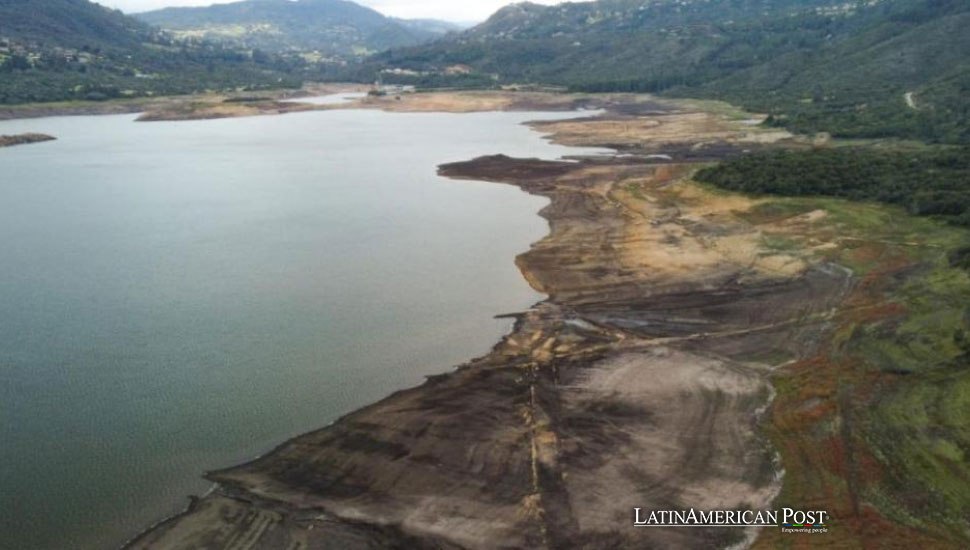Water Crisis in Bogotá Threatens Colombia’s Economy

Bogotá’s water reservoirs are critical, and the capital faces severe water rationing. This crisis could have far-reaching economic consequences, affecting industries, agriculture, and the overall stability of Colombia’s economy.
Bogotá’s Water Crisis
Bogotá, Colombia’s bustling capital, is facing a critical water crisis. The Chingaza reservoir system, which provides water to over eight million residents, is currently at just 43.36% capacity. This precarious situation has led to strict water rationing since April 2024, and authorities warn that if levels drop to 36%, even more stringent restrictions will be implemented. While this crisis poses an immediate threat to residents, the broader concern is the potential economic impact on the entire country. Colombia’s economy could suffer long-term consequences as water shortages disrupt industries, agriculture, and infrastructure.
The city’s government, led by Mayor Carlos Fernando Galán, has been sounding the alarm for months. Heavy rains in Bogotá have done little to replenish the reservoirs that feed the city, and the situation has steadily worsened. As water scarcity threatens daily life, businesses, and the well-being of residents, the larger picture reveals a looming economic challenge that Colombia must urgently address.
Bogotá is Colombia’s political center and economic engine, contributing significantly to the country’s GDP. The city relies heavily on the Chingaza reservoir system, which spans the Eastern Andes and provides most of the population water. However, this vital system is now strained by historically low water levels. The current situation is a stark reminder of how environmental challenges can quickly escalate into economic crises.
Water rationing in Bogotá began in April 2024 as reservoir levels dropped dangerously low. Since then, the situation has become increasingly dire. According to data from the Empresa de Acueducto y Alcantarillado de Bogotá (EAAB), the water levels in the Chingaza system decreased by 0.35% at the end of the most recent rationing cycle. These figures, though seemingly small, have a large-scale impact. For residents, water is now rationed in daily cycles. If the reservoirs reach 36%, the city will face a ‘Day Zero’ scenario where water supplies could be further restricted.
This water crisis’s impact is felt in homes across Bogotá and the city’s thriving industrial and commercial sectors. Water is essential for numerous economic activities, from manufacturing to services, and the shortage is already straining these industries. With no significant improvement, the city braces for worsening economic challenges as the water supply crisis deepens.
Industries and Agriculture Under Pressure
Water shortages in Bogotá have ripple effects throughout Colombia’s economy. Bogotá has significant industries, including food and beverage production, construction, textiles, and technology. These sectors depend heavily on water for daily operations, and water rationing is already slowing production rates and increasing company costs.
One of the hardest-hit sectors is agriculture. Colombia’s agricultural industry, which plays a crucial role in the national economy, relies on water from Bogotá’s reservoir system for irrigation and livestock management. Farmers in the surrounding areas already feel the effects of reduced water availability. Crop yields are down, and agricultural exports, a crucial part of Colombia’s trade, could significantly decline if the crisis persists.
For industries like manufacturing, the lack of water is not just a logistical problem—it’s an existential one. Many factories require significant amounts of water to operate efficiently, and any disruption in the supply chain can lead to delays, reduced output, and potential layoffs. The construction industry, another major contributor to Colombia’s GDP, is also vulnerable. Construction sites across Bogotá require water for everything from concrete mixing to site maintenance, and rationing has led to delays in projects and increased costs.
The economic fallout is compounded by the fact that large and small businesses must now factor in the cost of contingency measures, such as purchasing water from external suppliers or investing in water-saving technologies. While more giant corporations may be able to absorb these costs, small and medium-sized enterprises (SMEs) are at greater risk of financial strain.
Impact on Colombia’s Growth and International Trade
Colombia’s economic growth is at risk as the Bogotá water crisis escalates. The capital city’s financial activities contribute around 25% of the country’s GDP, and any disruption to its output has nationwide implications. With industries across Bogotá grappling with water shortages, Colombia’s export sector—mainly agricultural exports—could see significant setbacks.
Coffee, flowers, and fruits are among Colombia’s most important exports, and these industries are directly tied to water availability. If the water crisis continues, reduced agricultural yields could harm Colombia’s trade balance, decreasing the country’s competitiveness in international markets. The coffee sector, in particular, is a crucial driver of Colombia’s economic growth and job creation. A decline in coffee production due to water shortages would hurt the country’s economy and the livelihoods of thousands of Colombians who depend on the coffee industry for their income.
Moreover, Bogotá’s role as a hub for international trade and commerce means that any significant disruption to the city’s economy could send shockwaves throughout the region. Bogotá is a strategic point for foreign investments, trade negotiations, and international cooperation. As businesses in the capital city struggle with water scarcity, foreign investors may hesitate to expand their operations in Colombia, fearing the instability caused by environmental challenges.
Tourism, another major contributor to the Colombian economy, is also at risk. Bogotá attracts millions of visitors each year, and the water crisis could deter tourists, primarily if water rationing extends to hotels, restaurants, and public services. The loss of tourism revenue could further exacerbate Colombia’s economic difficulties, particularly in the short term as the city grapples with the ongoing crisis.
Solutions for a Sustainable Water Supply
As Bogotá’s water levels continue to drop, the need for sustainable solutions has become more urgent than ever. The city’s government has been implementing measures to conserve water and prevent further reservoir depletion. However, long-term solutions will require a coordinated effort between local, regional, and national authorities and the private sector.
One potential solution is improving water management infrastructure. While practical under normal conditions, the current system cannot handle prolonged droughts and water scarcity. Investments in modernizing Bogotá’s water infrastructure—such as repairing leaks, improving water recycling systems, and expanding storage capacity—could help mitigate the impact of future water shortages.
Another key solution is the promotion of water conservation practices among both industries and residents. Bogotá’s government has already launched public awareness campaigns urging citizens to reduce their water consumption. However, more can be done to incentivize businesses to adopt water-saving technologies and implement sustainable practices. Industries that consume large amounts of water, such as agriculture and manufacturing, should be encouraged to invest in efficient irrigation systems and alternative water sources to reduce their dependency on the Chingaza reservoirs.
Additionally, Colombia must explore alternative sources of water, such as desalination plants or the development of new reservoirs, to diversify the country’s water supply. While these solutions require significant investment, they are essential for ensuring a stable and reliable water source in the face of climate change and unpredictable weather patterns.
Finally, regional cooperation is critical. Colombia is not the only Latin American country facing water scarcity, and collaboration with neighboring countries on water management strategies could benefit the entire region. Sharing knowledge, technology, and resources across borders can help mitigate the impact of water shortages and ensure that Latin America is better prepared for future environmental challenges.
Also read: Cuba, Ecuador, Costa Rica, and Colombia: Leading Biodiversity Finance in Latin America
Bogotá’s water crisis is not just a local problem—it’s a national economic threat. The ongoing water shortages are already disrupting industries, agriculture, and infrastructure, with long-term consequences for Colombia’s growth and international trade. While the immediate focus is on managing the current crisis, the country must invest in sustainable solutions to prevent future water shortages and safeguard its economy. The challenge ahead is immense, but with coordinated efforts and forward-thinking policies, Colombia can navigate this crisis and emerge more resilient.





